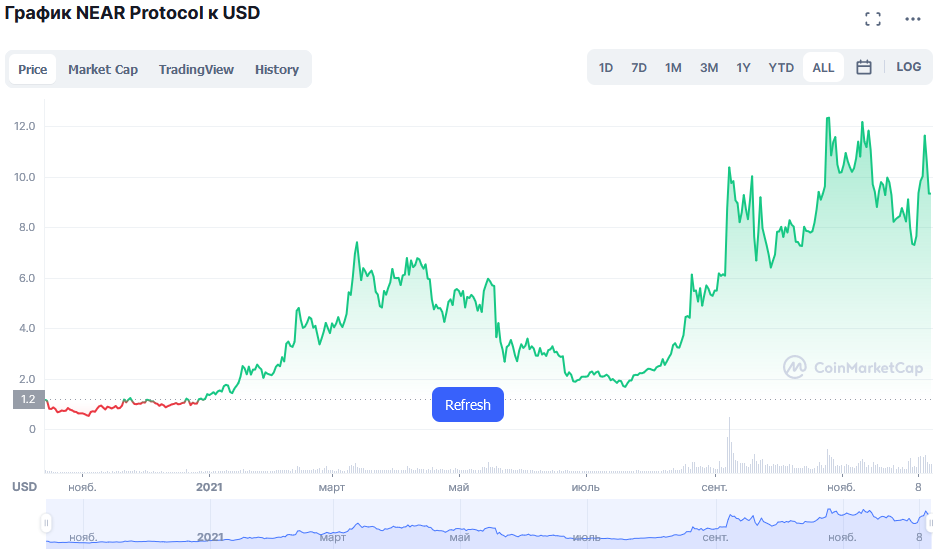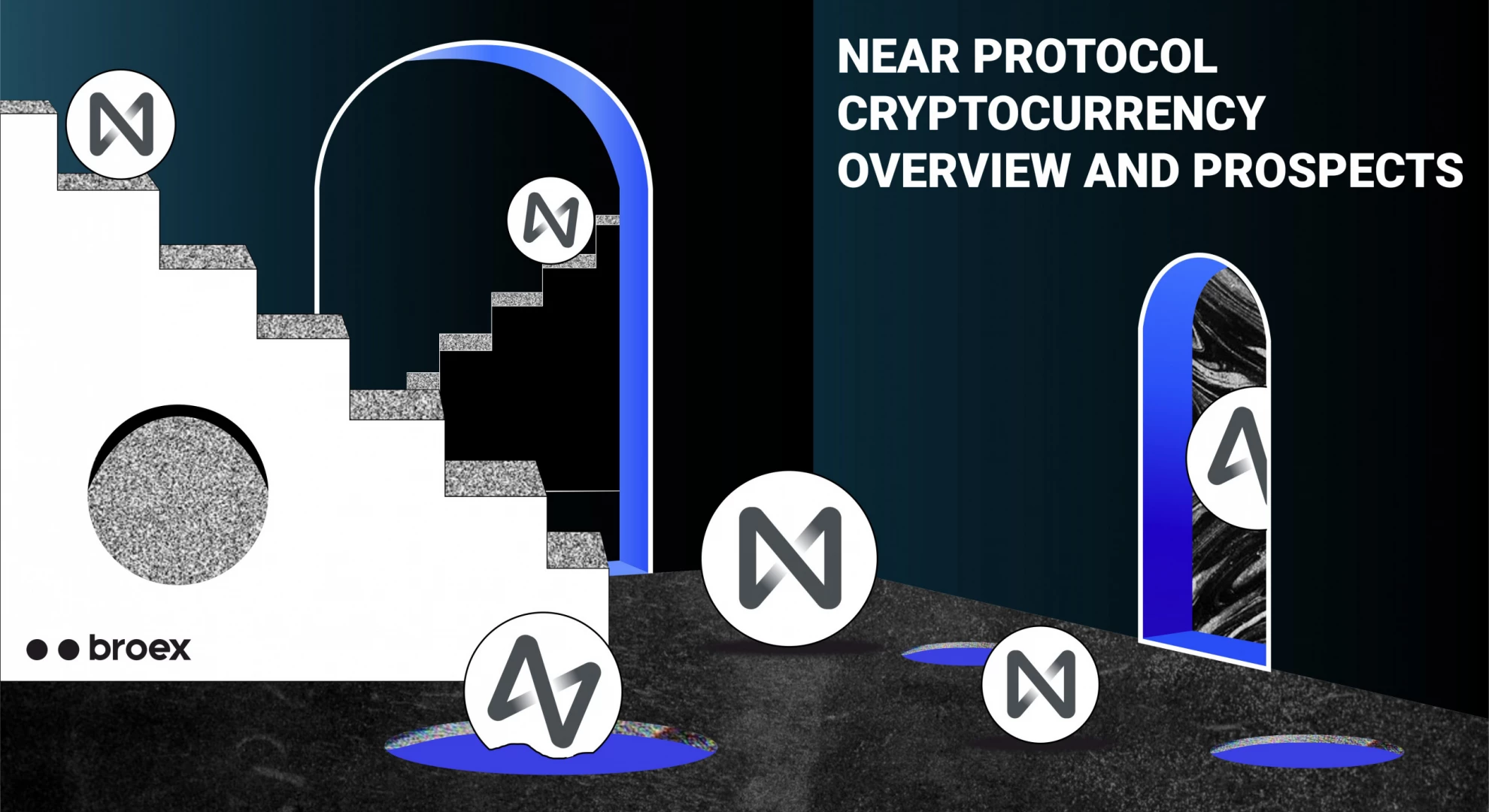Near Protocol blockchain is a platform for smart contracts with a simple toolkit for decentralized application developers. The network is Ethereum-compatible. Near Protocol uses the sharding mechanism (a method of separating and storing a single logical data set as multiple databases) Nightshade with the block creation mechanism Doomslug.
About Near Protocol blockchain
In our review of the Near Protocol cryptocurrency, we cannot avoid the question of what this blockchain is and how it works. As mentioned above, the underlying mechanism is sharding - data is divided into multiple databases, which allows any project to scale without losing throughput of the network and provides a high rate of information transfer (up to 100,000 transactions per second).
History of Near Protocol
The idea for Near Protocol cryptocurrency dates back to 2018 as part of the startup accelerator Y Combinator. Developers Alexander Skidanov and Ilya Polosukhin proposed their idea of a platform that could scale better than any modern blockchain.
Y Combinator has become a launching pad for big-name projects, including Coinbase, Dropbox, Reddit, Filecoin, and AirBNB.
After the developers announced the idea, they managed to get a team together fairly quickly, as well as to raise $15 million as an investment for development even without a finished product. Throughout 2018, the project team grew pretty quickly to 50 people.
The blockchain was released in October 2020. And the team transferred some management rights to the owners of the cryptocurrency Near Protocol. The Near Foundation was also created to monitor the design and development of the project.
It includes not only prominent representatives of the cryptocurrency community, but also Near Protocol blockchain co-founder Ilya Polosokhin. Once the foundation emerged, Near protocol evolved into a DAO (decentralized autonomous organization in which decisions are made based on voting).
How the Near Protocol blockchain works
The network is based on the Delegated Proof-of-Stake (consensus mechanism, in which a certain number of tokens must be held in a wallet to become a node owner), using sharding to improve efficiency.
Unlike the sharding used in other blockchains, such as Polkadot, all shards (a group of cells) are considered as part of a single blockchain. By using Rainbow Bridge, the Near Protocol cryptocurrency blockchain interacts with the Ethereum network.
In addition to sharding, the blockchain uses the Doomslug consensus mechanism. It allows nodes to generate blocks one by one. New blocks are created every second. And the validation turn changes every 12 hours.
The reward for running a validating node in the Near blockchain is calculated on an inflationary model. At the time of writing, 90% of the funds are distributed among the owners of the nodes, as well as those who invest in staking pools. 10% of the tokens generated from the creation of a new blockchain are sent to the Near Foundation.
Near Protocol Cryptocurrency Staking
One way to profit from investing in this blockchain is staking (similar to mining, a user stakes a certain amount of cryptocurrency as collateral to create new blocks in the network and validate transactions).
To get a node, it is necessary to stake a certain number of Near Protocol tokens. And their exact number is determined by how many coins are already stored by other validators within the same shard. This also determines the amount of reward each staker receives at the end of every epoch (12 hours).
There are 100 seats on each shard. In order to become a validator, you must buy at least one seat. The value of each is determined by the total number of Near Protocol tokens being staked in that shard.
If the user has insufficient funds to "reserve" a place in the shard, he may contact other members of the network through the community, who will delegate the necessary amount of tokens to him. That is how pools of tokens are created.
The principle of project management in Near Protocol
The design and development of the network is managed by the community. All proposals that are made by the community members are voted on, discussed and, if appropriate, executed by the developers.
At this point, the entire blockchain operates as a single shard. If the community finds it necessary to add new shards, the automatic Dynamic Resharding mechanism will create them.
In addition to the community, the network is managed by the Near Foundation. It decides on the sponsorship of development for the ecosystem, hiring new people to keep the protocol running, and the overall management of the project.
Benefits of Near Protocol blockchain
The pros of this network include:
- The ability to scale infinitely due to an innovative approach to working with data. This applies to the blockchain itself as well as to any apps that are based on it.
- Relative simplicity in the development of decentralized apps. The team offers the ability to create smart contracts using any programming language a developer finds convenient to work with (unlike many other similar projects, where the language for smart contracts is defined by the blockchain creators themselves).
- Ready-made application templates. The project team offers sample dApps that you can use to implement your own ideas.
- Ability to create smart contracts to generate profit from transaction fees.
- A simple and user-friendly interface. This allows users with any level of background to get started with apps and services.
- Pre-paid transactions allow you to give dApps users the app for free for testing.
- Simple registration. Users can sign up for apps without using complex keys or browser permissions.
- Own Wallet. The team offers all token holders their own token storage solution, Near Wallet.
- High transaction speed. The network is capable of processing up to 100,000 transactions per second, which is quite high in comparison with major contenders.
Near Protocol Cryptocurrency Overview, Prospects, Forecasts
The project held an ICO (Initial Coin Offering) in August 2020. More than 120 million tokens were sold during the online event. This amounted to about 12% of the total issue. 17% of the remaining 88% went to various marketing and community outreach programs.
Application of Near Protocol tokens
There are several ways to use coins of this distributed ledger internally:
- Payment for transactions within the network. The tokens will be used by both the developers themselves to write various smart contracts, and by the users who will work with future decentralized apps. The developers promise that fees in the Near Protocol blockchain will remain low, making it efficient to work with.
- Staking. Since the project is based on the DPoS consensus mechanism, token holders can send them to special addresses to profit from the ownership of the nodes. Staking in simple terms is a deposit (similar to a bank deposit), which generates a certain interest. The funds are paid to the owners of the nodes every 12 hours, according to the terms of the project.
- Delegation to pools. If a user doesn't have enough money to buy a place in shard, he can delegate his tokens to special pools which aggregate money from other participants of the community and create collective nodes in that way. The principle is very similar to mining pools, which aggregate the processing power of all participants to mine, for example, bitcoin or other coins based on the Proof-of-Work mechanism.
- Long-term investment with the aim of making a profit. Some users purchase Near Protocol cryptocurrency in order to keep it in their wallet and then resell when its value increases.
Near Protocol Partners
Despite the fact that blockchain has appeared relatively recently, several interesting projects have already been launched on it:
- Berry Cards. It's a marketplace for buying and selling NFTs (non-fungible tokens that are used to confirm the ownership of unique items). The specific feature of this marketplace is that it offers pixel-style artwork. Another important detail - the platform independently determines the value of this or that picture on the basis of a number of methods. In this case, Berry Cards is not just a platform for exchanging NFTs. It's a community of like-minded people, which discusses the further development of both the platform itself and the industry as a whole.
- Hip Hop Heads. This is another NFT project based on Near Protocol blockchain. It was created and launched in partnership with Ed Young, one of the founders of The Source Magazine, a landmark publication for this music trend. Collections of artists from different eras since the founding of hip hop are auctioned off. Fans have the opportunity to buy tokens using both cryptocurrency and credit cards.
Prospects of Near Protocol project
Considering the prospects of cryptocurrency Near Protocol, it's worth noting that the blockchain has already made itself known. On the basis of the platform, two projects in the field of NFT were released (at the moment, this is a very popular direction, with turnover reaching billions of U.S. dollars). Given the attractiveness of blockchain as a platform for developing new apps, it's just a matter of time before new partners emerge.
In addition, demand for blockchain from developers will be supported by the relative ease of creating smart contracts. Teams are free to use any programming language they are familiar with.
The platform implements ready-to-use application templates, which greatly simplifies the process of creating new dApps. This will lead to a large number of interested developers in the future. Therefore, the forecast for Near Protocol cryptocurrency is positive.
Blockchain uses an unusual system of transaction validation, through which a network with almost unlimited scalability and high transaction processing speed can be achieved. This should have a positive effect on the future prospects of Near Protocol cryptocurrency.

As for the price of Near Protocol cryptocurrency, it jumped by more than 10 times. At the time of writing, the quote is at $9, which is $3 less than the market highs. With interest in blockchain growing, the price of Near Protocol cryptocurrency could surpass historical highs.
Where to Buy Near Protocol Cryptocurrency
There are many ways to buy tokens of this project. The most reliable and secure one is to buy Near Protocol on the Broex platform. The platform offers the following advantages to its customers:
- Reliable regulated service. Broex is registered on the territory of the European Union. The company has a license for financial transactions with fiat money and cryptocurrency.
- Large selection of trading instruments. Broex officially cooperates with the Binance platform, which gives an opportunity to add any tokens available on the well-known platform. Broex website offers more than 600 currency pairs.
- Ability to deposit and withdraw via credit and debit cards, as well as popular electronic payment systems.
- Broex offers its customers secure storage. All tokens are stored on servers without an internet connection, which eliminates their stealing. As for fiat currencies, according to the regulations of European regulators, customers' money is stored on a separate circuit, which excludes access to it by website employees.
- Ready to invest ideas from Broex is an opportunity to buy a portfolio with assets. Customers with any level of training can take advantage of this service.
